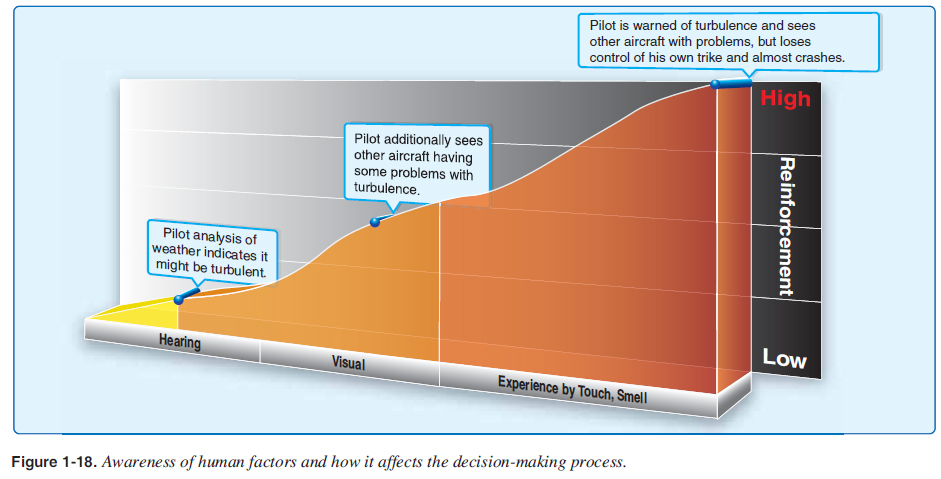
 |
|
||
CHAPTER 1. Introduction To Weight-Shift Control Runway Incursion Avoidance A runway incursion is any occurrence at an airport involving an aircraft, vehicle, person, or object on the ground that creates a collision hazard or results in a loss of separation with an aircraft taking off, landing, or intending to land. The three major areas contributing to runway incursions are:
Taxi operations require constant vigilance by the pilot and can be assisted by the passenger. This is especially true during fl ight training operations. Both the student pilot and the fl ight instructor need to be continually aware of the movement and location of other aircraft and ground vehicles on the airport movement area. Many fl ight training activities are conducted at nontowered airports. The absence of an operating airport control tower creates a need for increased vigilance on the part of pilots operating at those airports. Planning, clear communications, and enhanced situational awareness during airport surface operations will reduce the potential for surface incidents. Safe aircraft operations can be accomplished and incidents eliminated if the pilot is properly trained from the outset and, throughout his or her fl ying career, accomplishes standard taxi operating procedures and practices. This requires the development of the formalized teaching of safe operating practices during taxi operations. Positive Transfer of Controls During flight training, there must always be a clear understanding between the student and fl ight instructor of who has control of the aircraft. Prior to any dual training fl ight, the instructor should conduct a briefi ng that includes the procedure for the exchange of flight controls. The following three-step process for the exchange of flight controls is highly recommended. When a fl ight instructor wishes the student to take control of the aircraft, he or she should say to the student, “You have the fl ight controls.” The student should acknowledge immediately by saying, “I have the fl ight controls.” The fl ight instructor confi rms by again saying, “You have the fl ight controls.” Part of the procedure should be a visual check to ensure that the other person actually has the fl ight controls. When returning the controls to the fl ight instructor, the student should follow the same procedure the instructor used when giving control to the student. The student should stay on the controls until the instructor says: “I have the fl ight controls.” There should never be any doubt regarding who is fl ying the WSC aircraft. Numerous accidents have occurred due to a lack of communication or misunderstanding regarding who actually had control of the aircraft, particularly between student and fl ight instructor. Establishing the positive transfer of controls procedure during initial training will ensure the formation of a very benefi cial habit pattern. Aeronautical Decision-Making (ADM) A PIC’s attitude or mindset must always be alert in order to maintain the safety of the aircraft, passengers, and the general public on the ground. To accomplish sound aeronautical decision-making (ADM), a pilot must be aware of his or her limitations and well-being (physical and psychological health), even before beginning the fi rst prefl ight routine. While technology is constantly improving equipment and strengthening materials, safe flight comes down to the decisions made by the human pilot prior to and during fl ight. The well-being of the pilot is the starting point for the decision-making process that occurs while in control of the aircraft. Just as physical fatigue and illness directly affects a pilot’s judgment, so too will attitude management, stress management, risk management, personality tendencies, and situational awareness. Hence, it is the awareness of human factors and the knowledge of the related corrective action that not only improves the safety of operating a WSC aircraft, but also enhances the joy of fl ying. [Figure 1-18]  A good starting point is the Pilot’s Handbook of Aeronautical Knowledge (FAA-H-8083-25), which explains the decisionmaking process, resource management, situational awareness, pilot error, stress management, risk management techniques, and hazardous attitude antidotes. After reading and understanding those subjects, it should be understood that the scenarios presented are generally for more complex airplanes, but the thought process and results are the same for all aircraft. The information is not duplicated but the differences and additional information specifi c to WSC is provided in subsequent sections. The differences in the more complex airplane requirement scenarios presented in the Pilot’s Handbook of Aeronautical Knowledge versus WSC aircraft characteristics can easily be compared. Overall, the advantage of an LSA is the simpler design requiring less pilot attention than the complex requirements of more complicated designs that add to the pilot’s workload, such as:
The unique characteristics on the WSC aircraft that increase ADM tasks are:
|
| ©AvStop Online Magazine Contact Us Return To Books |